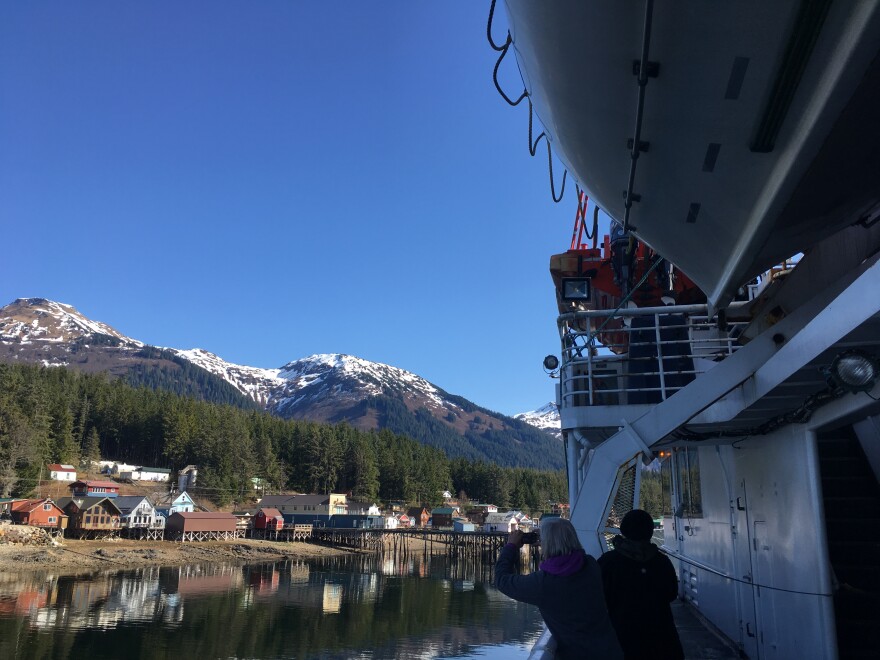The Alaska Marine Highway System says the ferry LeConte won’t return to service until May 15. And for at least two small Chichagof Island communities that translates into around seven months without a ferry.
The LeConte is one of two ships in the Marine Highway fleet that can maneuver into communities with small docks. It went in for an overhaul in October. State officials say they discovered around $4 million in additional steel work would be needed to bring the 45-year old vessel up to par.
Work has been at a standstill for at least three weeks.
Its sister ship the Aurora was also due for its overhaul this month. But rather than repair both ships state officials said they’d patch together the one needing the least amount of work.
On Thursday the state announced its decision: the LeConte would be repaired and should be back online May 15.
In the meantime, with both ships out of service Southeast has been on a much-reduced schedule, with four communities getting no ferries at all.
“I mean, it’s just ridiculous,” Tenakee Springs Mayor Dan Kennedy told CoastAlaska. “I feel like we should go up and close down the Alcan for a week and see how they like it."
Tenakee Springs has no airport or barge freight. The only other way in and out is by seaplane which mostly fly in fair weather.
“We got a couple guys with fishing boats who may be able to run back in and help keep the store stocked a bit,” Kennedy said. “But of course they’re more weather dependent than the ferry.”
That’s what the community of Pelican has been doing. It’s 40 miles west of Tenakee Springs on the opposite side of Chichagof, though there’s no road between them.
A salmon troller is preparing for its second run from Juneau with food and supplies to his small city.
But Pelican Mayor Walt Weller says it’s not a permanent solution.
“If the fishing picks up, or he goes winter king fishing, or the problem lasts until summer, then we’re not going to have that boat available at a decent rate,” Weller said.
The ferry Tazlina, one of a pair of $60 million Alaska-built vessels, has re-entered service in Southeast after plans to add side doors to allow it to load and unload efficiently were delayed.
It’ll be calling in Gustavus, which was among the communities whose ferry connection has been severed. It’ll also be attempting two runs into Angoon where a broken ramp has plagued that community’s dock and prevented larger ferries from berthing.
But Alaska Marine Highway System spokesman Sam Dapcevich says officials have found a workaround: a boom truck or crane will manually winch up Angoon’s broken ramp.
“We’re going to use heavy equipment to lift it up and when the vessel backs in we’ll lower it with heavy equipment onto the deck,” Dapcevich said.
He says DOT is putting the repair project out to bid with the hope of getting it repaired in coming months.
In the meantime, efforts by Angoon’s city government to hire a private catamaran to ferry passengers to Juneau for supplies is having trouble finding a way for the voyage to pencil out.
On Wednesday, Nov. 20 the city announced it had signed up 18 people for a run the following Sunday, which would translate into $300 per person each way. The notice said the city and local tribe were considering a subsidy.
“Please understand that there is the potential that we may not have enough passengers for a November run and might not be able to pull it off,” the city wrote in a Facebook post signed by Angoon Mayor Joshua Bowen.
Tenakee Springs Mayor Dan Kennedy says the state never should’ve forced communities into this position.
“I don’t see it as the municipality’s responsibility,” Kennedy said. “When you know, people moved here, bought land and we’ve had the Alaska Marine Highway. And without it? We’re just left out in the wind.”
Transportation officials haven’t said what will be done with the LeConte’s sister ship Aurora. Its Thursday statement says it needs 20 percent more steel work than the LeConte.
In the meantime, the Aurora is being laid up in Ketchikan’s Ward Cove with no immediate plans for an overhaul. This comes as the state has also announced it’s laying up its mainliner Malaspina rather than invest the $16 million it says is needed for steel work in that 56-year-old ship.

